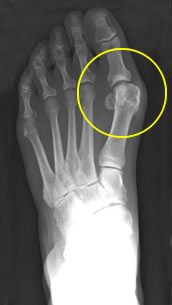in Foot and Ankle Surgery and Reconstruction
A bunion is the general term given to a condition of the big toe called hallux valgus. “Hallux” refers to the big toe and “valgus” means pointing towards the outside of the foot. The big toe therefore becomes deviated at the metatarsaophalangeal (MTP) joint towards the little toes. A bump then develops on the side of the big toe. The term “bunion” is commonly used to describe this condition.
In many patients no definite cause is found. There are links to tight shoes, such as high-heels because the feet are “squashed” into the shoe, but not all people who wear high heels will get a bunion. Genetics may play a role, with different generations of family complaining of this same condition. Pre-existing conditions that can pre-dispose people to developing a bunion include flat feet and muscular imbalance conditions such as polio or cerebral palsy. Different types of arthritis can be associated with bunions such as rheumatoid arthritis and osteoarthritis.
The main reason people seek medical attention is because of pain around the bump/bunion on the big toe. Patients often complain that they are unable to wear some of their shoes. As the toe gradually moves sideways towards the little toes a bump develops on the side of the MTP joint on the inside of the foot. This skin and tissues under the skin can get inflamed and painful especially when wearing shoes. Patients complain they have difficulty walking and participating in sports.
The clinical features as discussed above in addition to typical X-Ray findings can confirm the diagnosis of Hallux Valgus.

People often live with the symptoms for many years and then finally seek medical attention. If you decide not to see your doctor, the problem will tend to progress, usually slowly. The big toe can be pushed more towards the small toes and the 2nd toe can begin to bend upwards allowing the big toe to push underneath it. You can then develop problems with the 2nd toe riding up and rubbing on your shoe or pain under your little toes, with hard lumps or corns. Eventually arthritis may develop in your big toe. The condition can be treated at any stage. If following the development of the bunion arthritis develops in the big toe joint then surgery to simply realign the toe may not work and other options such as fusion of the big toe may need to be discussed.
The treatment is operative or non-operative.
Non-operative treatment aims to reduce the symptoms by reducing the pressure on the bunion or pain when you are active. This can be through the application of toe spacers or re-alignment splints, padded insoles, advice on shoe-wear or custom-made shoes. This is not a curative option, but may be suitable for some patients. In addition, some patients may find taking pain-killers or anti-inflammatory tablets beneficial.
Operative treatment is the only way to physically change the shape of your foot. It realigns your toe to correct the bunion deformity and will narrow the profile of your foot to allow you to regain your active lifestyle and wear the type of shoes you want.
Many patients are simply seeking advice on managing a problem. In mild cases modifying shoes or activities can prove a successful therapy however if non-operative measures have failed to improve symptoms then surgery is indicated. The timing of the surgery can be arranged to suit your needs.